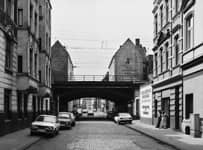The Brief: ‘You Are Here’ (Home)
– series of images based on the subjective interpretation of home.
– 6 images minimum
– connecting theme
Development images:
Research:
Initially I attempted to create images along the lines of those of Martin Parr and Nick Waplington, who looked into home settings and family life. I loved the dated decor that their images captured as well as Waplinton’s imaging of the movement of family life and behaviour. However, the only home I had time to access was my own, which, whilst conforming to the dated 1970s decor, was far too hectic to give way to any decent images.
Most of my ideas were rather too complex for the time scale and so I began thinking about the architecture of everyday life. I decided to focus on two things, the semi detached house that contains the contrasting lives of two families, and the streets in which we live – that feeling you get of ‘coming home’ when you turn onto your street after being away.
Topography:
I looked into topography, or the photographing of the ordinary, as a basis to begin with. Most famous for this are Hilla and Bernd Brecher, who photographed ordinary architecture and made them significant in the way in which they assembled the images. Alone, photographs of the ordinary are nothing but, well, ordinary, however together they speak of ‘the ordinary’. The Brecher’s work focused mostly on the industrial, often in a grid form- arguably equally industrial. This is something I wanted to translate into the ‘home’ realm.

When the water towers are put together, they make you think about the things you see everyday and compare them, they make you really look instead of accepting their existence. This is something a kept in mind when deciding on my images.
I also looked at the work of Robert Adams, finding his approach to photography fascinating:
“I began making pictures because I wanted to record what supports hope: the untranslatable mystery and beauty of the world. Along the way the camera also caught evidence against, and I eventually concluded that this too belonged in pictures if they were to be truthful and useful.”
He manages to capture both the beauty and the un-beauty of the places he photographs whilst also capturing a narrative. In particular, I took inspiration from his composition and the colours in his photos and I have tried to use this inspiration in my work.

I also looked at the work of Thomas Struth, in particular his ‘Unconscious Places’ series of images. Here, he photographs the streets of major cities, from rich to poor, covering all kinds of houses. I appreciated the symmetry in his work, the clean lines and clear streets, however I found it very difficult to find streets unpopulated with cars and this is the downfall of my work.
![]()

References:
http://www.tate.org.uk/art/artists/bernd-becher-and-hilla-becher-718
https://www.theguardian.com/artanddesign/2014/feb/24/robert-adams-photographs-american-west-paris
http://www.thomasstruth32.com/smallsize/photographs/unconscious_places_1/index.html

